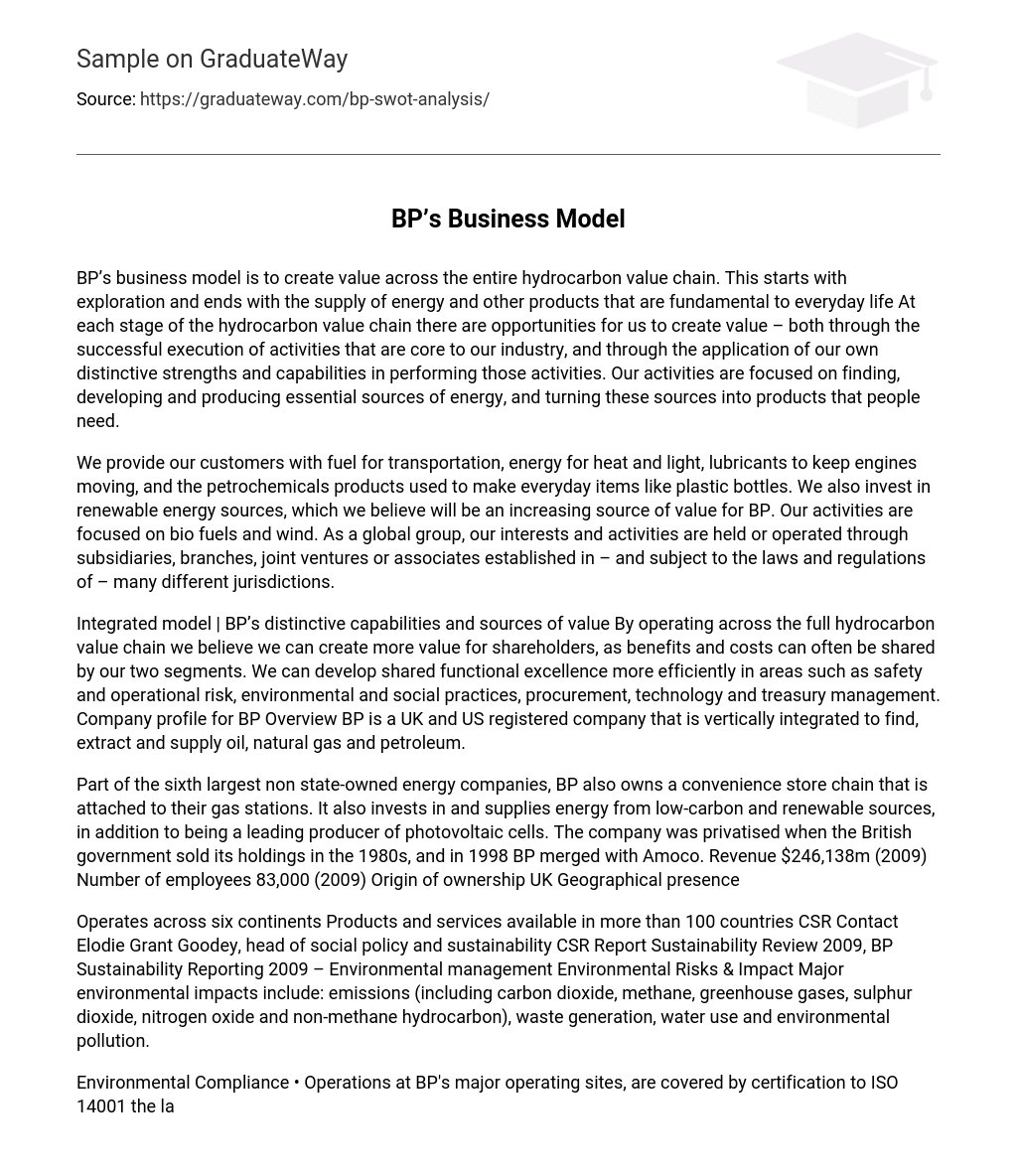BP’s business model is to create value across the entire hydrocarbon value chain. This starts with exploration and ends with the supply of energy and other products that are fundamental to everyday life At each stage of the hydrocarbon value chain there are opportunities for us to create value – both through the successful execution of activities that are core to our industry, and through the application of our own distinctive strengths and capabilities in performing those activities. Our activities are focused on finding, developing and producing essential sources of energy, and turning these sources into products that people need.
We provide our customers with fuel for transportation, energy for heat and light, lubricants to keep engines moving, and the petrochemicals products used to make everyday items like plastic bottles. We also invest in renewable energy sources, which we believe will be an increasing source of value for BP. Our activities are focused on bio fuels and wind. As a global group, our interests and activities are held or operated through subsidiaries, branches, joint ventures or associates established in – and subject to the laws and regulations of – many different jurisdictions.
Integrated model | BP’s distinctive capabilities and sources of value By operating across the full hydrocarbon value chain we believe we can create more value for shareholders, as benefits and costs can often be shared by our two segments. We can develop shared functional excellence more efficiently in areas such as safety and operational risk, environmental and social practices, procurement, technology and treasury management. Company profile for BP Overview BP is a UK and US registered company that is vertically integrated to find, extract and supply oil, natural gas and petroleum.
Part of the sixth largest non state-owned energy companies, BP also owns a convenience store chain that is attached to their gas stations. It also invests in and supplies energy from low-carbon and renewable sources, in addition to being a leading producer of photovoltaic cells. The company was privatised when the British government sold its holdings in the 1980s, and in 1998 BP merged with Amoco. Revenue $246,138m (2009) Number of employees 83,000 (2009) Origin of ownership UK Geographical presence
Operates across six continents Products and services available in more than 100 countries CSR Contact Elodie Grant Goodey, head of social policy and sustainability CSR Report Sustainability Review 2009, BP Sustainability Reporting 2009 – Environmental management Environmental Risks & Impact Major environmental impacts include: emissions (including carbon dioxide, methane, greenhouse gases, sulphur dioxide, nitrogen oxide and non-methane hydrocarbon), waste generation, water use and environmental pollution.
Environmental Compliance • Operations at BP’s major operating sites, are covered by certification to ISO 14001 the latest being the Texas City Refinery which achieved ISO 14001 in 2010. • BP’s CSR report has been externally audited by Ernst and Young. Targets & Performance • Emissions & Energy: Targets localised to countries and sites in which BP operates. In 2009, there has been an increase of 6% over the previous year in total CO2 emissions; the same increase has also been shown for other greenhouse gases.
This increase has been explained as a result of the intensity of activity associated with the start-up of the Tangguh liquefied natural gas project. • Water: In 2009, there has been an increase of 5% over the previous year in water usage. • Waste: In 2009, there has been an increase of 12% over the previous year in waste generated. Spotlight – Mono2TM BP’s newly developed process for growing silicon, Mono2TM, has been shown to convert 18% of sunlight energy into power – a relatively high efficiency level compared with many mono crystalline cells. Relationships • Ernst and Young
UPDATE: On the 20th April BP’s Deepwater Horizon rig in The Gulf of Mexico exploded killing 11 workers and causing an oil spill considered to be the largest environmental disaster in US history. On the 15th July 2010 the leak was stopped for the first time since the explosion which the US government estimated was causing 1. 5m to 2. 5m gallons of crude oil to spill into the Gulf each day. Prior to the spill BP was Britain’s biggest company, with a stock market value of ?121bn. But the shares have been hammered in the wake of the disaster, with more than ?50bn wiped off the company’s share value.





